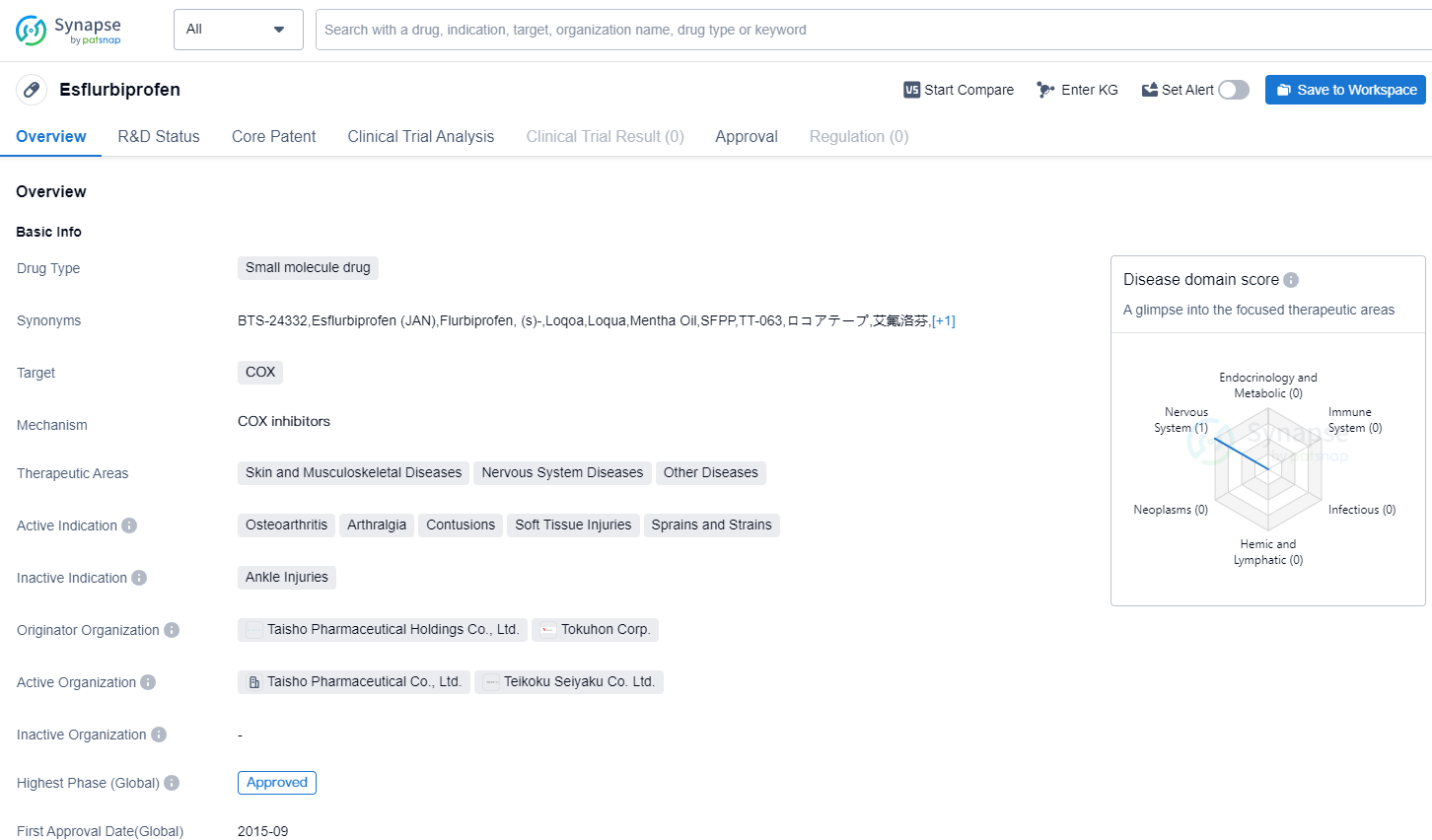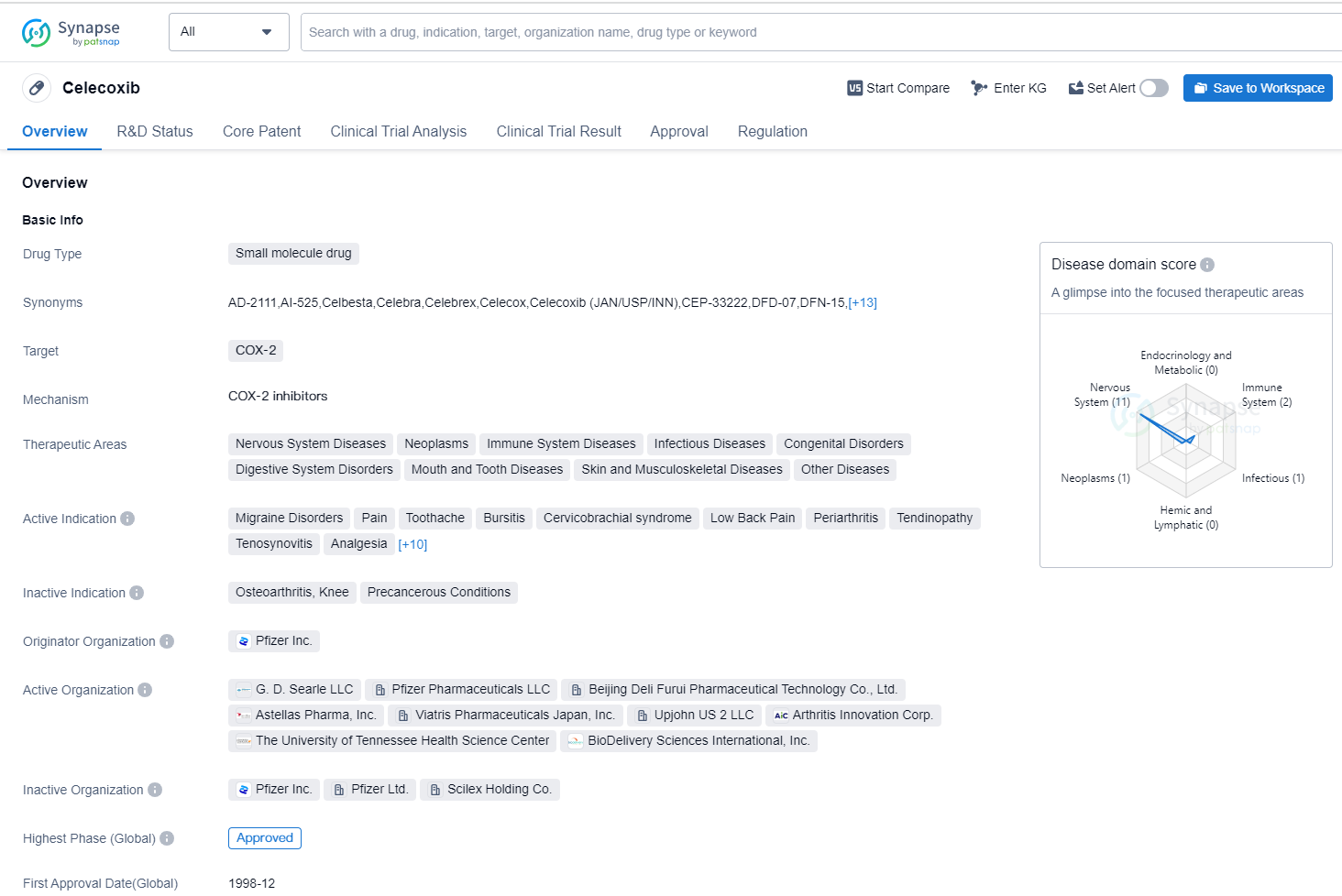Analysis on the Research Progress of COX Inhibitor
COX, also referred to as Prostaglandin-Endoperoxide Synthase (PTGS), is a significant enzyme in organisms that is responsible for the formation of important biological modulators that include prostaglandins, prostacyclins, and thromboxanes.
Medicines that inhibit COX can alleviate inflammation and pain symptoms. Medications that inhibit Cyclooxygenase activity, such as aspirin, have been available to the public for around 100 years. Two subtypes of Cyclooxygenase have been identified, named COX-1 and COX-2. In many instances, the COX-1 enzyme is a constitutive component (e.g., gastric mucosa), whereas COX-2 is inducible (e.g., sites of inflammation). Aspirin, ibuprofen, and other nonsteroidal anti-inflammatory drugs (NSAIDs) function by inhibiting Cyclooxygenase. COX inhibitors mainly consist of NSAIDs, which decrease the levels of various prostaglandins (PG) within the body by inhibiting Cyclooxygenase (COX) activity.
Prostaglandins are key inflammatory mediators that cause fever, pain, and inflammation, so by lowering the prostaglandin levels, it can offer anti-pyretic, analgesic, and anti-inflammatory effects respectively.
COX Competitive Landscape
According to Patsnap Synapse, as of 26 Sep 2023, there are a total of 599 COX drugs worldwide, from 607 organizations, covering 316 indications, and conducting 8058 clinical trials.
👇Please click on the picture link below for free registration or login directly if you have freemium accounts, you can browse the latest research progress on drugs , indications, organizations, clinical trials, clinical results, and drug patents related to this target.
The analysis of the target COX reveals a competitive landscape with multiple companies actively involved in research and development. GSK Plc, Viatris Inc., Pfizer Inc., AbbVie, Inc., and Bayer AG are the companies growing the fastest under the current target, with GSK Plc having the highest number of approved drugs. Pain is the most common indication for drugs targeting COX, followed by indications such as common cold, rheumatoid arthritis, and osteoarthritis. Small molecule drugs are progressing most rapidly, indicating a focus on developing innovative treatments in this category. China, the United States, Japan, and the European Union are the countries/locations developing fastest under the current target, with China showing significant progress. Overall, the target COX presents a competitive landscape with a focus on pain management and small molecule drug development, with China emerging as a key player in the pharmaceutical industry.
The preferred medication for home management of early symptoms in COVID-19 positive patients: celecoxib
Celecoxib is a small molecule drug that primarily targets COX-2, an enzyme involved in inflammation and pain. It has been approved for use in various therapeutic areas, including Nervous System Diseases, Neoplasms, Immune System Diseases, Infectious Diseases, Congenital Disorders, Digestive System Disorders, Mouth and Tooth Diseases, Skin and Musculoskeletal Diseases, and Other Diseases.
👇Please click on the image below to directly access the latest data (R&D Status | Core Patent | Clinical Trial | Approval status in Global countries) of this drug.
The drug has shown efficacy in treating several conditions, such as Migraine Disorders, Pain, Toothache, Bursitis, Cervicobrachial syndrome, Low Back Pain, Periarthritis, Tendinopathy, Tenosynovitis, Analgesia, Inflammation, Juvenile Arthritis, Dysmenorrhea, Primary dysmenorrhea, Acute Pain, Ankylosing Spondylitis, Adenomatous Polyposis Coli, Osteoarthritis, Rheumatoid Arthritis, and Pain Postoperative.
A matched cohort study on 216 cases of mild to moderate COVID-19 outpatient managed by family doctors found that early outpatient treatment based on selective COX-2 inhibitors reduced the incidence of subsequent hospitalization (primary outcome) and related costs. Celecoxib effectively reduces inflammatory response and prevents disease progression, making it the preferred COX-2 inhibitor for early home treatment of COVID-19. A small prospective study involving 44 confirmed COVID-19 inpatients (82% with moderate symptoms) found that compared to standard treatment, the use of selective COX-2 inhibitors (Celecoxib) as adjunctive therapy for 7-14 days can prevent clinical disease progression and improve chest CT grading. Compared to other COX-2 inhibitors, Celecoxib has a higher lipophilic property, which indicates higher bioactivity, making it the preferred COX-2 inhibitor for early home treatment of COVID-19.
In terms of regulatory status, Celecoxib has undergone Priority Review and Accelerated Approval processes, which suggest its potential to address unmet medical needs or provide significant benefits over existing treatments. Additionally, it has been designated as an Orphan Drug, indicating its intended use for rare diseases or conditions.
Overall, Celecoxib is a well-established drug with a long history of use in various therapeutic areas. Its approval in multiple countries and recognition by regulatory authorities highlight its safety and efficacy profile. As a small molecule drug targeting COX-2, it offers potential benefits in managing pain, inflammation, and various diseases. The objective presentation of the drug's information allows for an unbiased understanding of its characteristics and potential applications in the field of biomedicine.
Esflurbiprofen
Esflurbiprofen is a small molecule drug that belongs to the class of nonsteroidal anti-inflammatory drugs (NSAIDs). It primarily targets the enzyme cyclooxygenase (COX), which is involved in the production of prostaglandins, substances that cause inflammation and pain in the body. By inhibiting COX, esflurbiprofen helps reduce inflammation and relieve pain.
👇Please click on the image below to directly access the latest data (R&D Status | Core Patent | Clinical Trial | Approval status in Global countries) of this drug.
 Esflurbiprofen was developed by Taisho Pharmaceutical Holdings Co., Ltd. and Tokuhon Corp., both of which are originator organizations involved in the pharmaceutical industry. The drug has reached the highest phase of development, which is approval, indicating that it has successfully undergone clinical trials and met the necessary regulatory requirements for market authorization.
Esflurbiprofen was developed by Taisho Pharmaceutical Holdings Co., Ltd. and Tokuhon Corp., both of which are originator organizations involved in the pharmaceutical industry. The drug has reached the highest phase of development, which is approval, indicating that it has successfully undergone clinical trials and met the necessary regulatory requirements for market authorization.
The first approval of esflurbiprofen occurred in September 2015 in Japan. This means that it was the first country/location where the drug received regulatory approval for commercialization and use. It is important to note that the information provided is based on factual data and does not include any fictional details or subjective interpretations.
In summary, esflurbiprofen is a small molecule drug that targets the COX enzyme and has been approved for the treatment of various conditions related to skin and musculoskeletal diseases, nervous system diseases, and other diseases. It was developed by Taisho Pharmaceutical Holdings Co., Ltd. and Tokuhon Corp. and received its first approval in Japan in September 2015.





